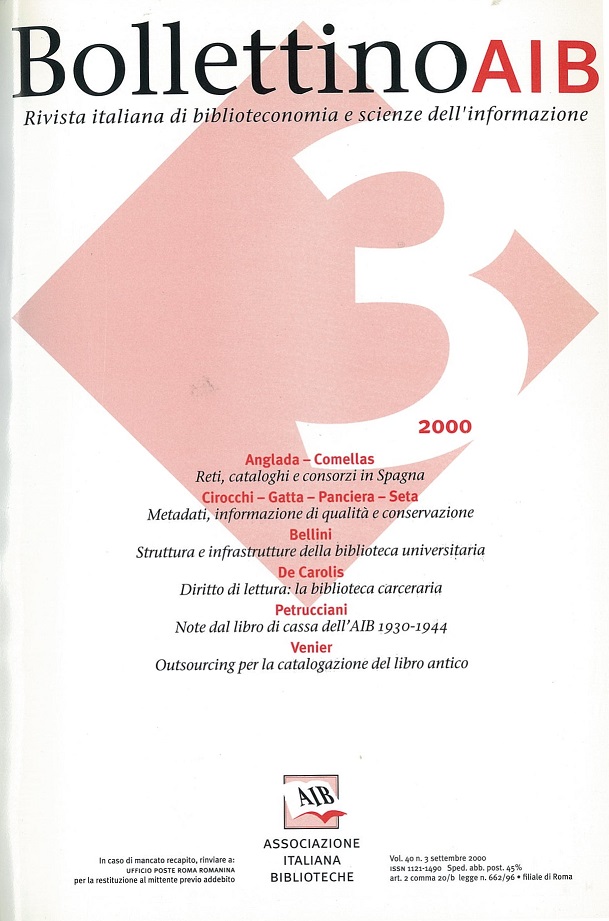Metadata, quality information and preservation of digital resources
Main Article Content
Abstract
The growing attention to metadata is evidence of the current trend of the World Wide Web to evolve towards forms more suited to scientific communication. This would be structured in such a way as to allow the retrieval of relevant information that is safeguarded from the point of view of its authenticity and security. We can therefore say that the trend is towards "quality information", which can be defined by four key words: structured, enriched by metadata, updated, certified.
The article means to focalize attention on metadata, taken as a decisive clearance junction of this evolutionary phase of the Web, in which the interests of the specialists of information for the structuring and standardization of data and the "economic" interests of those who offer commodities and services on the net are united. While it is impossible to examine all the current experiences in this sector, it intends expounding the information and occasions for reflection that emerged from the work of the group in relation to some cases of actual application of metadata: the digitalization of Italian parliamentary papers, the creation of metadata to integrate parliamentary papers already in digital form, the creation of specific metadata for legislative provisions, within the sphere of the project Norma in rete (Regulations on the Internet).
The metadata actually make it possible to more easily and precisely carry out the three basic activities that an information system must ensure: identification, use and conservation of electronic resources. Although all the resources present on the Web are provided in some way with metadata, there is a lack of the homogeneity and consistency that are by now usual in the world of analogic information (from the form of presentation of the documents to cataloguing); on the other hand digital resources offer a much greater complexity and variety, and therefore the fundamental problem of standardization is presented in a completely new way. The research proceeds according to two complementary guiding principles: one consists in structuring homogenous, even if complex, sets of metadata, aimed at specific applications and projects and therefore addressed to a definite area of digital resources; the other aims at developing a standard for universal diffusion. This would be very simple and based on the principle of description by the author. The ultimate objective is that of interoperability. On the one hand this is pursued by paying special attention to the compatibility of specific sets with the standard, in such a way as to be able to map different sets and even traditional description standards. On the other, because of the complexity of some information systems, the presence, with regard to the resources themselves, of different sets by function (e.g., one for the description of the contents and one for preservation) and by complexity (a rapid description can then be followed by a more complete one) is allowed, and devices for hosting them in a common architecture are being studied.
Particular attention is devoted to the Dublin Core, a tendentially universal standard, characterized by a limited number of elements defined through clear and universally intelligible semantics and prepared for ensuring interoperability with other standards and tools for the search of online resources. The article sums up the state of the discussion regarding the development of the elements of the set and their descriptors in order to satisfy the most specific requirements of different communities of users, which are likewise free to use the syntax deemed most opportune. If the Dublin Core can be offered as a model for the "semantics" of the metadata, there can also be interesting developments as regards the "syntax" from the adoption of the RDF (Resource Description Framework) model which, by exploiting the potential of the XML language, proposes an approach based on the concept of relation between data and metadata.
Other interesting occasions for reflection come from the extensive and increasingly felt problem of the preservation of electronic resources, both with regard to the permanence of access and the guarantee of authenticity. In outlining the main strategies for preservation of electronic resources, the role that metadata play within these latter is emphasized: both in the so-called "migration" strategy and, especially, in the "emulation" strategy, they constitute a structured attempt to describe the requirements for the long-term management of electronic documents.
A special mention must be made of the OAIS (Open Archival Information System) model, developed especially to respond to the requirement of long-term preservation of digital resources. Although originated from the world of scientific research, it is of great interest for anyone who produces and means to preserve electronic resources. It offers a dynamic vision of the metadata for conservation, seen as an integral part of an AIP (Archival Information Package), formed from the digital resource that is intrinsically linked to its metadata. Different projects of the library area, such as CEDARS and NEDLIB are currently developing parts of the OAIS model within projects that also include testing of the emulation strategy.
Article Details

This work is licensed under a Creative Commons Attribution-ShareAlike 4.0 International License.
